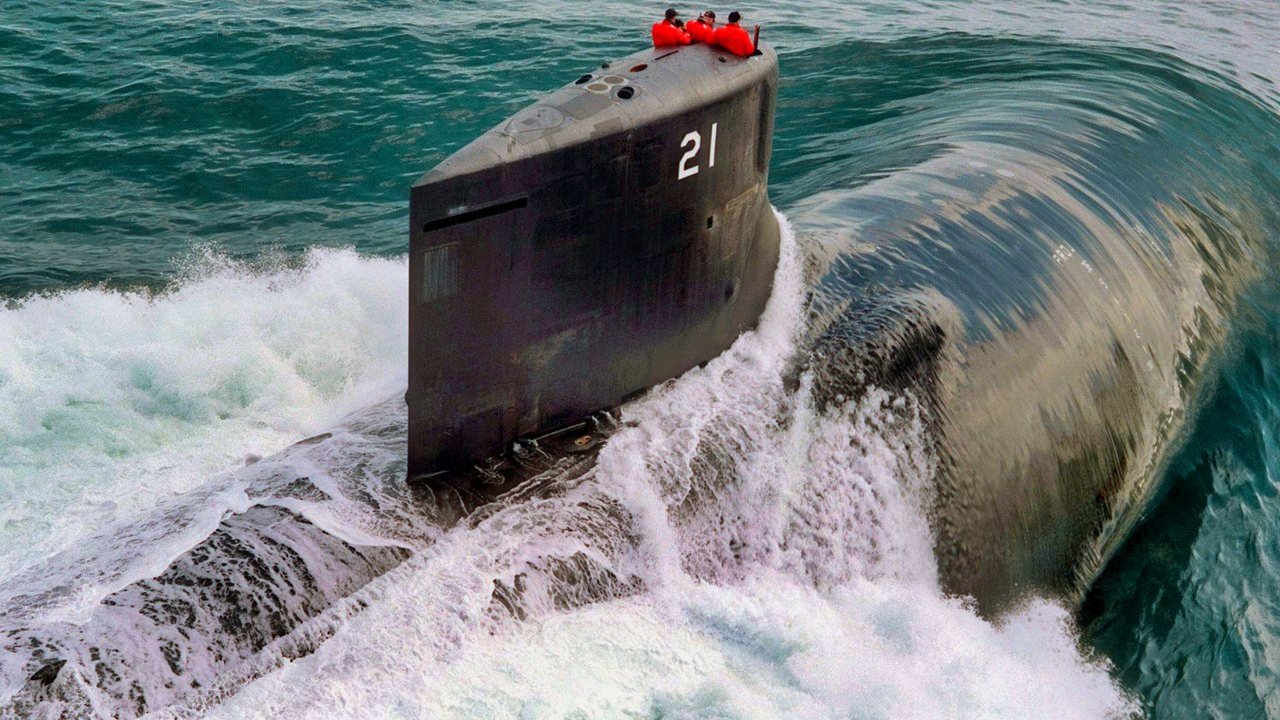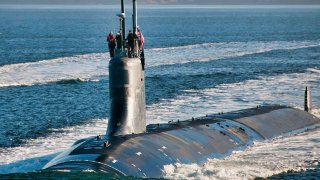Why Did Seawolf-Class Submarine USS Connecticut Slam Into an Underwater Mountain?
Three years ago, the Connecticut was prowling the depths of that sea, operating very near to the advanced Chinese naval submarine base on Hainan Island. Then, tragedy struck.
The USS Connecticut is one of only three Seawolf-class submarines that the U.S. Navy operates. They are among the most advanced submarines in the world. Designed in the 1980s and deployed in the 1990s, the Seawolf was to be one of the replacements for aging Los Angeles-class attack subs. Incorporating some of the most sophisticated surveillance technology, the Seawolf class was built to be much more than just another attack submarine.
The only problem was that the Seawolf class is extraordinarily expensive. With the end of the Cold War and the collapse of the Soviet Union, the U.S. Congress did not see the need to fund the Seawolf program as first intended.
As a result, only a few of these incredible submarines were acquired by the Navy. Despite being more than 20 years old, the Seawolf-class continues to be among the most advanced subs in the world. Whenever they are deployed, they help tip the balance of engagement in America’s favor.
The Seawolfs are especially good at operating in distant, hostile environments such as the Arctic, and they have an incredible mission success rate. Whenever one of these systems leaves service for any period of time, their loss creates a significant capabilities gap for the Navy.
That’s why it was a crisis for the Navy when, in 2021, the USS Connecticut was taken out of action after supposedly crashing into an underwater mountain along the bottom of the relatively shallow South China Sea.
Three years ago, the Connecticut was prowling the depths of that sea, operating very near to the advanced Chinese naval submarine base on Hainan Island.
What was the USS Connecticut Doing?
The Chinese facility on Hainan Island is believed to be one of the most sophisticated naval facilities in the world – certainly China’s most advanced. It is a surveillance bonanza for the United States to get close to that secretive facility and spy on it, which might well be what the Connecticut was doing.
There was some controversy surrounding the Connecticut incident. The Navy’s official story was that the sub was transiting through international waters and was not doing anything questionable, despite being near the Chinese facility.
The Chinese, meanwhile, insisted that the Connecticut was engaged in “irresponsible” behavior and suggested, without proof, that the Connecticut could have leaked radioactive materials into the South China Sea.
The Connecticut will not be back at sea until at least 2026.
But what happened?
In cases like this, it is unlikely that, if anything untoward did occur, the public would ever learn about it – at least not for several decades. So, for the sake of this piece, let’s say that the Navy’s official story for what happened is the most likely to be true.
USS Connecticut: Looking At What COULD Have Occurred:
With that said, given how important America’s submarine fleet is, and how shabby America’s shipyards have become, let’s explore some alternatives. Keep in mind, we are not saying these happened or there is any evidence, but let us explore some possibilities.
China’s military has developed a robust anti-access/area denial (A2/AD) capability designed to stunt the U.S. Navy’s power projection into regions of the world that Beijing covets, such as the South and East China Seas as well as the Taiwan Strait. This means that the Americans will have to rely more heavily on their submarine fleet.
China’s navy understands this, so Beijing is now attempting to devise capabilities with which to mitigate the real threat that America’s submarines pose to China’s navy. China has turned to truly sophisticated technologies and techniques for hunting American submarines.
1. 6G Terahertz Tracking Plus Advanced Underwater Drones
Last year, researchers at the Chinese Academy of Science’s Fujian Institute of Research on the Structure of Matter announced they had developed a “highly sensitive submarine detection system that can detect even the faintest traces of advanced submarines from significant distances.”
Thanks to China’s investment in 6G communications technology, their scientists claim they have figured out how to use the terahertz frequency, which is the range between microwave and infrared radiation. China further claims a working application for this technology.
Marrying unmanned underwater vehicles to this detection method would give China significant advantages in deterring America’s submarine threat. And China’s navy has already developed extra-large (XL) UUV systems.
According to the Asia Times’ Gabriel Honrada, satellite imagery confirmed that two of China’s XLUUVs are at the Sanya Naval Base on Hainan Island.
One of the XLUUV platforms docked at Sanya is believed to be connected to the HSU-001 UUV, which carries smaller UUVs and can deploy undersea mines. In Honrada’s assessment, this XLUUV can actively search and track “enemy submarines without endangering [Chinese] manned surface vessels or submarines.”
If these platforms were already operating out of Sanya, it is possible that the Connecticut was attempting to spy on the base from nearby international waters, was detected, chased away by this system, and ultimately, accidentally, crashed into a nearby seamount in its haste to avoid detection from this next-generation system.
2. Using Lasers to Track US Submarines
In 2021, the Shanghai Institute of Optics and Fine Mechanics said it had tested lasers that can detect objects more than 160 meters (525 feet) beneath the water. According to Michael Peck, that’s twice as deep as current equipment. Using green- and blue-beamed lasers, Chinese scientists at the institute said they had proved that the system could work. In turn, the Chinese team claimed it built a finely tuned sensor to detect underwater movement from a submarine.
More important, though, the Chinese have said for years they have a satellite that carries aboard it a laser emitter that can be used to track American submarines when they are submerged. There is some reason to believe they have such technology.
Could any of this be a reason for Connecticut's troubles? Hard to say...
3. Synthetic Aperture Radar and Their Hypersonic Torpedo
China has spent the last several years deploying multiple of its Yaogan electronic-reconnaissance satellites into Earth orbit. These satellites represent a major step forward for China’s anti-submarine-warfare capabilities. They employ what is known as a Synthetic Aperture Radar system.
The Yaogan system is most akin to the U.S. Naval Oceanographic Surveillance System, which is used to intercept radio signals from the ground and then use those signals to triangulate the locations of warships at sea. The Chinese are so protective of the Yaogan satellite constellation that they have deployed a co-orbital “bodyguard” satellite to better defend it from any potential U.S. anti-satellite weapon attack.
Two years ago, Li Pengfei of the National University of Defense Technology in Changsha announced that his team of researchers had developed a “cross-medium” supersonic weapon that is launched into the air, travels at Mach 2.5, and dives into the ocean during its terminal phase, becoming a torpedo. Li boasted that “no existing shipboard defense can protect against” this weapon.
This untested trans-medium supersonic weapon, when married to the next-generation capabilities of any of the aforementioned tracking systems, could spell doom for a successfully targeted American submarine.
Overcoming the Threat
This leaves the Navy in a pickle. Luckily, it seems as though the Chinese navy is not as advanced in their ability to roll back the American submarine threat from their shores as their A2/AD systems are at stopping America’s surface fleet. China is clearly dedicated to cutting off the U.S. Navy’s access to regions of the Indo-Pacific that Beijing aims to control.
The Pentagon must prepare to counter these new threats to their submarine fleet.

The Connecticut is out of commission for at least another two years. That was an accident in peacetime, whether or not it was the result of hostile action by Chinese forces operating out of Hainan Island.
Just imagine what lengths China will go to in order to prevent the U.S. Navy from deploying its otherwise lethal submarines into contested areas such as the South and East China Seas or the Taiwan Strait during an actual war, which is coming much sooner than people realize. Navy planners and Pentagon acquisitions specialists need to develop countermeasures to keep American submarines lethal against China's growing underwater A2/AD threat.
About the Author
Brandon J. Weichert, a National Interest national security analyst, is a former Congressional staffer and geopolitical analyst who is a contributor at The Washington Times, the Asia Times, and The-Pipeline. He is the author of Winning Space: How America Remains a Superpower, Biohacked: China’s Race to Control Life, and The Shadow War: Iran’s Quest for Supremacy. His next book, A Disaster of Our Own Making: How the West Lost Ukraine, is due October 22 from Encounter Books. Weichert can be followed via Twitter @WeTheBrandon.


